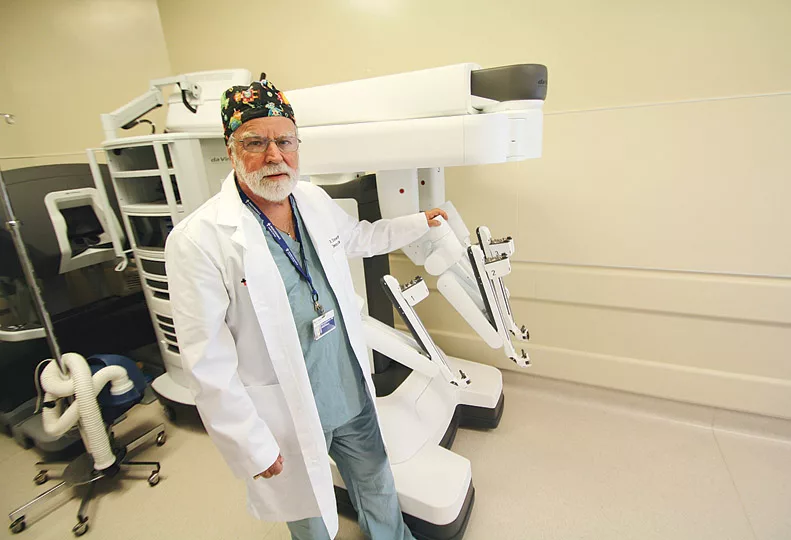Sacred Heart adds recently approved surgical robot
Newer technology can be used on more procedures

Providence Sacred Heart Medical Center & Children’s Hospital has bought and installed the newest generation of the DaVinci robotic surgery device, a machine that’ it expects will enable it to perform surgeries it hadn’t been able to do robotically.
Dr. Steven Brisbois, division chief for women’s services for Providence and its head of robotic surgery, says the hospital is using the device, called the DaVinci Xi, for gynecological procedures initially but eventually will use it for other types of surgery.
The device received FDA approval last April. Manufactured by Sunnyvale, Calif.-based Intuitive Surgical Inc., the device reportedly costs between $1.8 million and $2.3 million.
Installed at Sacred Heart in early August, the DaVinci robot has been used to perform just under 20 surgical procedures so far. Cancer Care Northwest PS gynecological oncologists Drs. Melanie K. Bergman and Elizabeth A. Grosen have used it extensively, Brisbois says.
“Our decision was that we should reserve it for physicians who would make the best use of it,” he says.
Thus far, physicians have used it for what Brisbois describes as simpler procedures, such as removal of fibroid tumors or removal of the uterus for women with uterine cancer. Brisbois himself plans to use the device for the first time next month.
In the coming months, he says, the device is expected to be employed for procedures that require broader access to a patient’s abdomen, specifically for ovarian cancer surgery.
“The purpose of the new design is to allow the robotic surgeon to use the robot in cases where you couldn’t use it before,” Brisbois says.
During a robotic procedure, a surgeon sits at a console controlling a four-armed device placed bedside. Each arm has tool attachments and imaging technology that are inserted into a patient’s body through small abdominal incisions and guided by a surgeon with hand and foot controls.
Typically, Brisbois says, the console is about 10 feet away from the device itself and communicating wirelessly, though it can be much farther away. The technology initially was developed for battlefield procedures, where surgeons could work remotely on injured soldiers. While possible, long-distance procedures aren’t typical or practical; it’s ideal to have a surgeon near the patient, he says.
The new DaVinci is the fourth such machine that Sacred Heart has bought and is using currently. It has had robotic surgery capabilities for about 15 years, and the technology has been used for various types of procedures, including heart-valve replacement.
Currently, the hospital hosts about 400 robotic surgeries annually, Brisbois says, and the new machine likely will be used for around four procedures a week on top of that.
He says the technology has improved over time from one generation of the DaVinci device to the next; he likens the responsiveness and image quality advancements to going from driving a 1950 Ford to driving a 2014 Cadillac.
The DaVinci Xi is designed differently from other generations of the device in that the robotic arms are attached to a boom that hangs above a patient during surgery. In past models, the arms extend from the body of the device.
That is significant, Brisbois says, because it gives a surgeon access to the entire abdominal area, from a patient’s diaphragm to the pelvic floor.
Previous versions of the DaVinci device only can be used on either the top half or the bottom half of the abdomen. If a surgery requires work on both areas, the tools must be extracted from a patient’s body and either the patient or the machine must be moved, which is time consuming and requires a patient to be under anesthesia longer. Some operating rooms are configured so that such a move isn’t possible, Brisbois says. Consequently, the technology often was ruled out as an option for ovarian cancer surgeries and others.
The cost of a procedure that involves using a DaVinci is substantially higher than laparoscopy, which is another type of minimally invasive procedure that involves using handheld tools and imaging technology inserted through small incisions in a patient’s abdomen. However, robotic surgery is less expensive than surgery that involves making large incisions in a patient’s body.
One of the largest distinctions—and benefits to patients, Brisbois says—is the difference in recovery time. With robotic surgery, a patient typically leaves the hospital the same day or has a one-night stay, compared with an average five-night stay after conventional surgery.
Time in surgery can be less with robotic surgery once a physician become proficient with the technology, Brisbois says.
Related Articles


_c.webp?t=1763626051)
_web.webp?t=1764835652)

